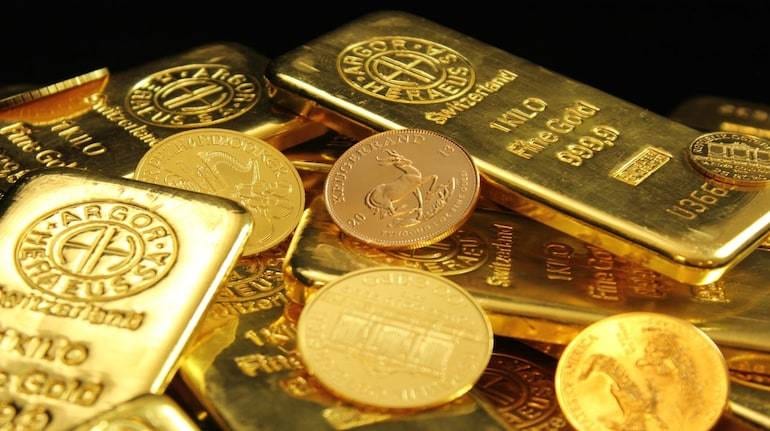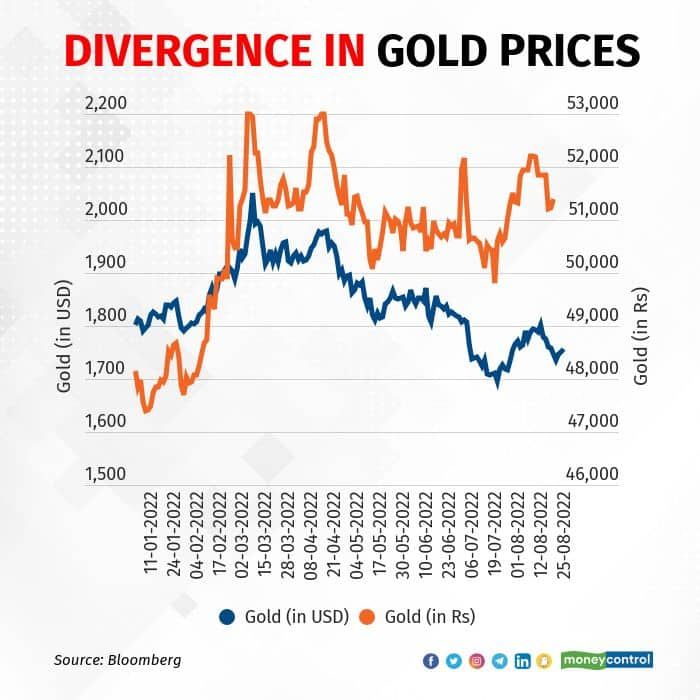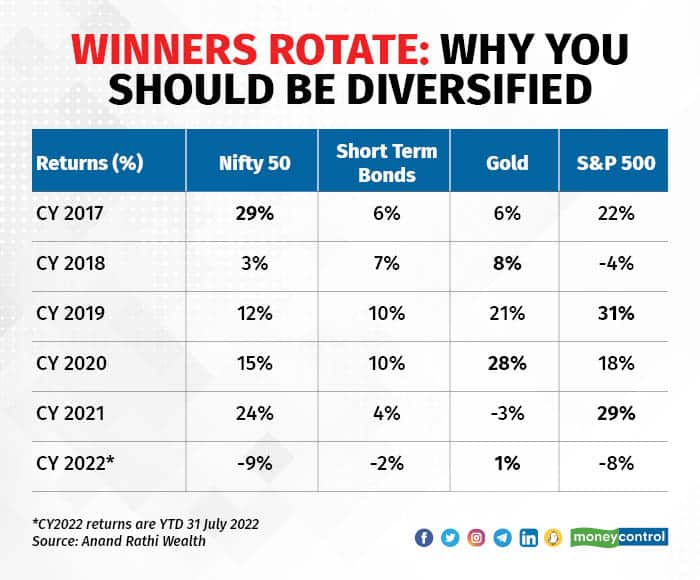



A three-pronged attack in 2022--from accelerating inflation, rising interest rates and volatile stock markets--has caused grief to investors. In such times, gold is often seen as a safe haven. Yet, even gold prices in global markets are falling in line with other risk assets, making investors nervous. Does it mean gold is no longer a safe haven?
Gold is a volatile asset class and its price can make a big move in no time.
Twice in recent time, it proved to be a safe haven in difficult times, its price increasing from $ 1,471 per troy ounce to $ 2,063 in March-August 2020 when the world fretted about COVID-induced lockdowns, and from $1,797 to $2,050 in February-March 2022 when Russia invaded Ukraine.
To be sure, at times it can test the patience of the investors. For example, after hitting a high of $711 in 1980, it moved down, and again scaled that level in CY2006. This volatile behavior makes it difficult to predict the price of gold.
Explaining the fallGenerally, the gold prices tend to react to bad news quickly. As central bankers the world over accepted that inflation is sticky in the backdrop of the Russia-Ukraine war, gold price should have gone up. But the price came down in dollar terms.
Compared to a high of $2,050 on March 8, 2022, gold is now trading at $1,744 – a fall of 14.3 percent.

This was an outcome of rising interest rates in the US to contain inflation. Money started flowing into the US as interest rates started rising, strengthening the dollar. A strong dollar is negative for gold prices.
Rising interest rates increase the opportunity cost of holding gold since the metal does not pay interest. That makes investors dump gold when interest rates rise, suppressing the price. Since the US dollar served as a safe haven, gold prices came down.
Yet, in Indian rupee terms, the gold price fell only 3.4 percent over the same period, as the local currency depreciated against the greenback. The rupee has fallen to 79.92 per dollar from 76.91 – a fall of 4 percent. Also, the Indian government increased the customs duty on gold in July 2022 by five percentage points to 12.5 percent, which in turn pushed up the gold price. Exposure to gold has actually helped Indian investors stay in the game.
Inverse correlationGold has a negative correlation with stocks and it has been demonstrated many times in the past, save short-lived phases when both asset classes moved in same direction.

For example, in CY2017, when the Nifty 50 and S&P 500 indices delivered 29 percent and 22 percent returns in rupee terms, respectively, gold gave only 6 percent return.
In CY2018, when S&P 500 lost 4 percent and the Nifty 50 gained 3 percent in a volatile year, gold gave an 8 percent return.
Even in CY2022 till July 31, 2022, both the Nifty 50 and S&P 500 had lost 9 percent and 8 percent, respectively, gold was still up 1 percent. Short-term bonds too lost money (minus 2 percent) as interest rates were hiked by the Reserve Bank of India.
Time to stick to the basicsExtreme opinions are being heard in the world of investments as some investors worry about inflation and recession and others cite prospects of a bright future with the worst of COVID likely behind us. Experts are of the opinion that the economy is at a crossroads and the markets are trying to discount the future as the macro-economic picture keeps changing, causing volatility and change in investor sentiment.
“Though investors have voiced (concern on the) possibility of a recession, there are no visible signs of it. Wages and gas prices are going up and there is no poor sentiment in the labour market,” said Sandeep Bagla, CEO of Trust Mutual Fund. “Despite inflation, gold has corrected in dollar terms as the US dollar is strong. Interest rates increases may not immediately bring down inflation. Hence, as of now, the market is in a wait-and-watch mode and clarity will emerge over a period of time.”
What should you do?It is time to ignore the noise and focus on your financial goals. Seldom can experts get it right on how much time it will take to correct all the ill-effects of COVID-19 on the global economy. If the interest rates are raised further to contain inflation, it will impact demand in the economy, bring down corporate earnings growth and stock prices too.
Also, the impact of higher interest rates need not necessarily be seen immediately. Inflation may take some time to cool off and may lead to further volatility in asset prices.
An investor has no control over these factors so it is best to remain focused on one’s financial goals. Sticking to your asset allocation and investing in a diversified portfolio should help.
“If you expect inflation to remain sticky and interest rates to go up, then it is better to cut equity exposure. Allocate money to gold and short-term bonds maturing in around one year,” says Bagla.
Feroze Azeez, Deputy CEO, Anand Rathi Wealth, recommends investing in a combination of equity mutual funds, sovereign gold bonds and medium-term government securities to generate inflation-beating returns.
“Gold is an integral part of the portfolio for investors. It is an effective hedge against inflation and currency depreciation. The sovereign gold bond pays interest at the rate of 2.5 percent in addition to the exposure to gold prices, along with tax-free returns if held to maturity. Hence it is the best way to invest in gold,” he says.
Risk, rewardIndian equities are expected to remain volatile but they may reward you in the long term. Also they are going to be a key component of your portfolio, especially in times when debt is earning a negative real yield (rate of inflation is higher than the rate of interest) and amid weakness in gold prices.
“Indian equities are expected to do well in this decade as we have a healthy banking system in place after a clean-up of non-performing assets, real estate sector has seen revival and the manufacturing sector is expected do well, further boosting our exports,” said Ashish Shanker, MD and CEO, Motilal Oswal Private Wealth.
But do not go overboard on one asset class, instead invest across asset classes for generating healthy risk-adjusted returns, he cautions.
In a high inflation environment, a multi-asset portfolio can work better for you if you rebalance it at regular interval to ensure that exposure to various asset classes is aligned with your desired asset allocation.
Discover the latest Business News, Sensex, and Nifty updates. Obtain Personal Finance insights, tax queries, and expert opinions on Moneycontrol or download the Moneycontrol App to stay updated!
Find the best of Al News in one place, specially curated for you every weekend.
Stay on top of the latest tech trends and biggest startup news.